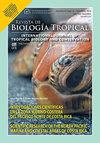首次对巴拿马太平洋海岸Azuero半岛的粗齿海豚(Steno bredanensis)(偶蹄目:海豚科)不寻常的大量搁浅进行汞和稳定同位素评估
IF 0.6
4区 生物学
Q4 BIOLOGY
引用次数: 0
摘要
小型鲸类动物是良好的环境污染生物指标;然而,关于它们在中美洲的生态毒理学状况的知识很少。在巴拿马,从野生种群中获取样本以确定海洋海豚的生态毒理学状况是有限的;因此,搁浅事件为获取样品提供了另一种选择。2016年4月,在Azuero半岛(巴拿马太平洋海岸)发生了一次罕见的大规模搁浅事件,60只粗齿海豚(Steno bredanensis)搁浅,其中10只在海滩上死亡。目的:首次测定该地区粗齿海豚体内总汞(THg)浓度及δ13C和δ15N稳定同位素值。方法:收集9份成人皮肤样本,用70%乙醇保存,后验分析THg浓度和稳定同位素值。结果:THg浓度范围为4 764 ~ 18 689 ng g-1干重(dw)(平均= 12 841;SD = 5 083 ng g-1 dw), δ13C值在−16.8 ~−15.2‰之间(平均值=−16.2;SD = 0.6‰),δ15N值在14.3 ~ 15.9‰之间(均值= 15.0;SD = 0.5‰). 结论:Azuero半岛报告的该物种的高THg浓度与世界其他地区(如巴西里约热内卢州中北部和哥伦比亚加勒比地区的La Guajira)报告的粗齿海豚的值一致。汞(Hg)浓度升高可能与粗齿海豚的饮食有关,根据这里发现的δ15N值,似乎主要是基于高营养水平的猎物,与低营养水平的生物相比,高营养水平的猎物在其组织中积累了更多的汞。然而,需要更多的饮食研究来支持这些发现。继续监测传统的饮食分析,以及鱼类和海豚的污染水平,对于了解巴拿马海豚的生态毒理学是必要的。本文章由计算机程序翻译,如有差异,请以英文原文为准。
First mercury and stable isotope assessment from an unusual mass stranding of rough-toothed dolphins (Steno bredanensis) (Artiodactyla: Delphinidae) in Azuero peninsula, Pacific coast of Panama
Introduction: Small cetaceans are good bioindicators of environmental contamination; however, knowledge about their ecotoxicological status in Central America is scarce. In Panama, access to samples from wild populations to determine the ecotoxicological status of oceanic dolphins is limited; therefore, stranding events provide an alternative for obtaining samples. In April 2016, a rare mass stranding event occurred in the Azuero Peninsula (Pacific coast of Panama), where 60 rough-toothed dolphins (Steno bredanensis) stranded, including ten which died on the beach.
Objective: To assess total mercury (THg) concentrations, and δ13C and δ15N stable isotope values in rough-toothed dolphins for the first time in this region.
Methods: Nine skin samples were collected from adults, stored in 70 % ethanol, and posteriorly analyzed to determine THg concentrations and stable isotope values.
Results: THg concentrations ranged from 4 764 to 18 689 ng g-1 dry weight (dw) (mean = 12 841; SD = 5 083 ng g-1 dw), δ13C values ranged between −16.8 and −15.2 ‰ (mean = −16.2; SD = 0.6 ‰), and δ15N values ranged between 14.3 and 15.9 ‰ (mean = 15.0; SD = 0.5 ‰).
Conclusions: High THg concentrations reported for this species in the Azuero Peninsula are consistent with values reported for rough-toothed dolphins in other areas worldwide, such as the central-northern Rio de Janeiro State in Brazil and La Guajira in the Colombian Caribbean. Elevated mercury (Hg) concentrations may be related to the rough-toothed dolphin diet, which according to δ15N values found here, appears to be based mainly on high trophic level prey that bioaccumulate more Hg in their tissues compared to lower trophic level organisms. However, additional dietary studies would be required to support these findings. Continuing monitoring of traditional dietary analysis, as well as contamination levels in fish and dolphins, is necessary to understand the dolphins’ ecotoxicology in Panama.
求助全文
通过发布文献求助,成功后即可免费获取论文全文。
去求助
来源期刊

Revista De Biologia Tropical
生物-生物学
CiteScore
1.80
自引率
0.00%
发文量
23
审稿时长
4-8 weeks
期刊介绍:
The Revista de Biología Tropical / International Journal of Tropical Biology and Conservation is a mainstream scientific journal published since 1953 and covered by Web of Science; Science Citation Index; Current Contents; Google Scholar; Scopus, SciELO and nearly 50 additional indices.
A double blind system guarantees you a fair evaluation, and our world class editorial and scientific boards provides a first decision in three working days. The journal is Full Open Access and is widely read where your article can have the highest real impact.
Since its beginning in 1953, the Revista follows these principles: objective and independent evaluation of all manuscripts; transparency in all processes; ethical use of procedures, data, specimens and subjects; fair treatment of all parties; and absolute predominance of scientific rigor over any other aspect.
 求助内容:
求助内容: 应助结果提醒方式:
应助结果提醒方式:


